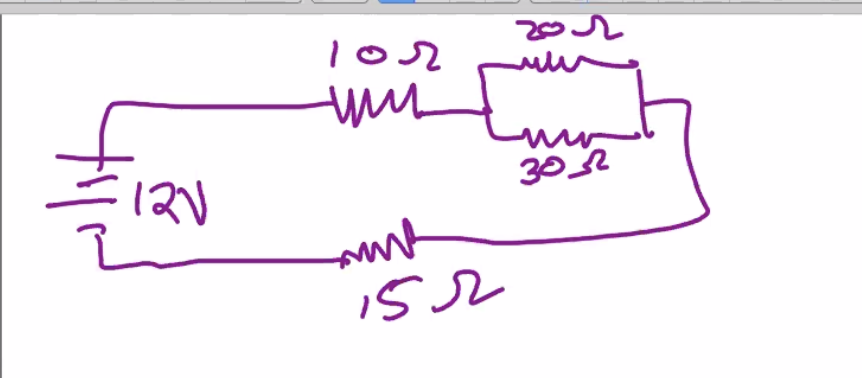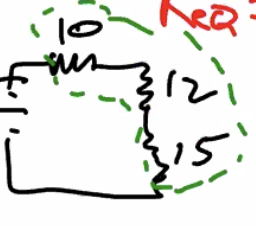Backlinks
1 Combining Resistors Method
The KBhPHYS201KirkoffsLaws Kirkoff's Laws themselves often requiring solving >6x6 matrixes to solve equations quickly. Which is hard.
1.1 Series
If you have two resisters…
–—|||–—|||–—
With the first having a resistance of \(A\Omega\) and the second \(B\Omega\).
The total resistance would simply be \((A+B)\Omega\).
- Same as equivalent of "electricity!" go through the first then the second
#disorganized
1.2 Parallel
Smaller area |–—|||-–— | Bigger area |===|||====
\(R_2 = R_1 \times \frac{A_1}{A_2}\)
\(R_{eq} = R_1 \times \frac{A_1}{A_1+A_2}\)
\(\frac{1}{R_{eq}} = \frac{A_1+A_2}{A_1R_1}\)
\(\frac{1}{R_{eq}} = \frac{1}{R_1} + \frac{A_2}{A_1R_1}\)
\(\frac{1}{R_{eq}} = \frac{1}{R_1} + \frac{1}{R2}\)
Resistance equation for series :pointup:
#disorganized
Calculate resistsance
1.3 "Combine Resistors" Method

Figure 1: Screen Shot 2020-09-14 at 11.02.45 AM.png
1.3.1 Parallel Resistors as Single Resistors
Per the previous resisters rules, that \(\frac{1}{R_{eq}} = \frac{1}{R_1} + \frac{1}{R2}\), we could treat the \(20 \Omega\) and \(30 \Omega\) in parallel as a single resistor of \(12 \Omega\).
Now the circut becomes even simpler:

Figure 2: Screen Shot 2020-09-14 at 11.05.49 AM.png
1.3.2 Sequence Resistors as Single Resistors
Per the sequence resisters rules, that total resistance is \((A+B)\Omega\), we could combine these three resistors as a \(37 \Omega\) resistor.
1.3.3 Combined Current
We know that \(12V / 37\Omega = 0.324 Amps\) is the current that returns to the battery and what the battery starts with, for if we treat the circuit as a single resistor, the 12 volts would only be working against.
From there, once we have a current for beginning and end, we could work our way up backwards by calculating the final voltage.
- Multiples battries can't be solved with the combined resistor method
- So, first guess the current flow
- Each batteries' current will flow back to itself
- When currents meet, they will combine
- Use currents identified before + Kirkoff's second law
- Use Kirkoff's first law to find loops (and hence equations) that, together, covers all components
- If resulting currents is negative, that means that you drew the
current in the wrong direction, or you are charging a battery
- Either way, if the signs are preserved to solve the rest of the equation, you should be fine numerically
- Just update your graph to reflect the actual currents' directions
LED longer leg is positive